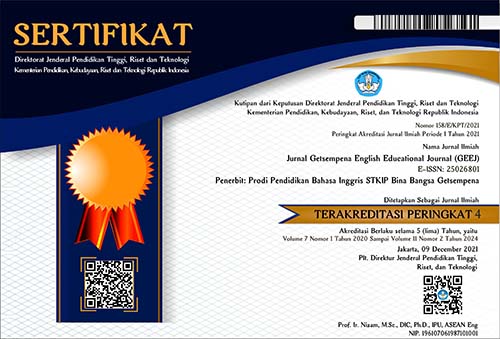ERROR ANALYSIS OF STUDENTS’ FREE WRITING
(A Descriptive Study at The English Department Of STKIP Bina Bangsa)
Abstract
This study was conducted to identify the types of errors that made by the second year students of English Department of STKIP Getsempena Bina Bangsa in their writing-I and to analyze what factor causes the students make errors in their writing. There are about 16 students who have taken the writing class. This qualitative study was conducted by document analysis and interview. The document analysis was done by collecting students’ writing papers; it was taken from the lecturer who taught academic writing class. The paper became the primary source supported by related references as the secondary sources. The whole primary data were classified based on the types of errors, and then they were explained. The writer also used interview protocol to cross check the data got from document analysis. This was important technique to gather the information about the factor causes the students make errors in their academic writing. The research finding shows the type of error that the students often made many errors in tenses. These errors occurred due to their lack of understanding about tenses and their usage. The other minor errors are considered mistakes because they know the rules, especially in using capital, punctuation, and determiners. Based on the interview protocol, the errors were made because of the influence of the first language; the students often think in Indonesian then write in English. The process of transferring the language infected the errors. This also was influenced by the students’ habit that seldom read the writing product after they write it. Actually, the errors can be revised if the students can pay much more attention to their writing product. From this evidence, the writer suggested that teachers teach and train their students in constructing sentences in many forms of tenses as prewriting activity. Other suggestion for the teachers is that they remind students about minor mistakes to prevent repeated mistakes. The teacher also has to plan valuable and effective feedback in order to enhance students’ development in writing skill.
References
Broadman, Cynthia A. (2008). Writing to Communicate: Paragraph to Essay (second edition), Pearson: Longman.
Brown, H. Douglas. (2001). Teaching by Principles; An Interactive Approach to Language Pedagogy, Second Edition, San Francisco: San Francisco State University Press.
Byrne, Donn. (1980). English Teaching Perspectives, England: Longman Group Ltd.
Ellis, Rod. (1986) Understanding Second Language Acquisition, Oxford: Oxford University Press.
Corder, Stephen Pit. (1981). Error Analysis and Interlanguage. Oxford, Oxford University Press.
Corder, Stephen Pit. (1967). The Significant of Learners' Errors. International Review of Applied Linguistics.
Hammil, Donald D. (1975). Teaching Children with Learning and Behaviour Problems, Boston, MA, USA: Allyn and Bascon.
Mennens, H., B. Wilkinson. (2002). Academic Writing Skill, Universiteit Maanstreit
Richards, Jack C. (1974). Error Analysis Perspectives on Second Language Acquisition. London: Longman Group Ltd.
Sanal, Fahrettin. (2007). Error Analysis Based Second Languge Teaching Strategies, http:// citeseerx. ist. psu. edu/ messages/ downloadsexceeded. html, accessed on August 23, 2011.
Seliger, Herbert W., Elana, Shohamy. (1989). Second Language Research Methods, Oxford: Oxford University Press.
White, R.V. (1988). Academic writing: Process and Product. In P. C. Robinson (Ed.) Academic writing: Process and Product. London: Modern English Publications: British Council.
Yusuf, Rinasari. Error Analysis And Error Correction In Foreign Language Teaching. Retrieved on March 9, 2011 from http://www.jurnallingua. com/edisi-2008/13-vol-1-no-2/61-error-analysis-and-error-correction-in-foreign-language-teaching.html.
























